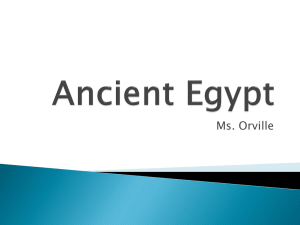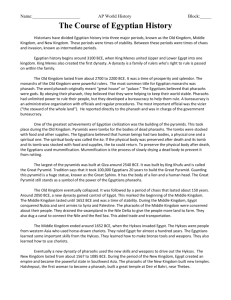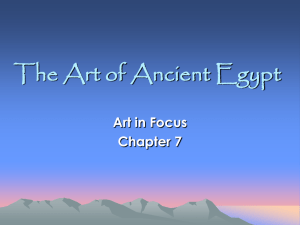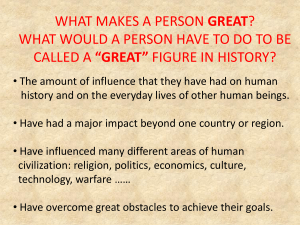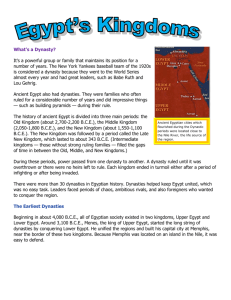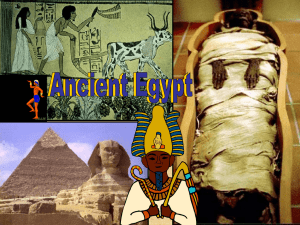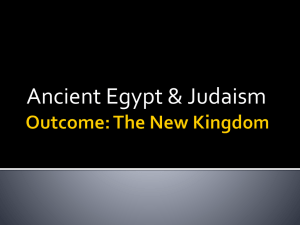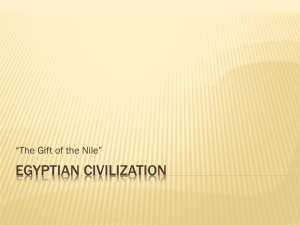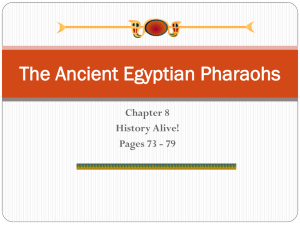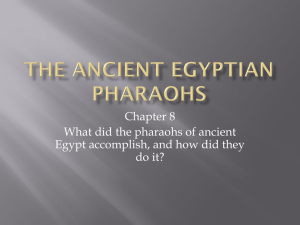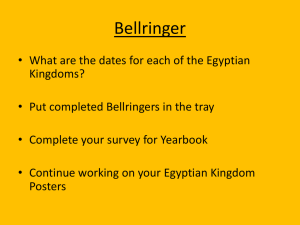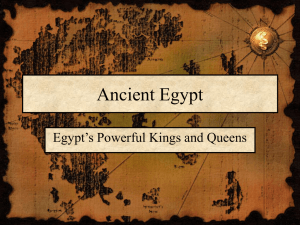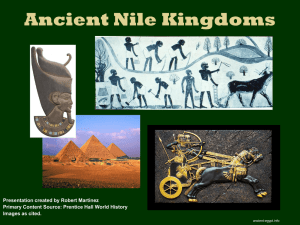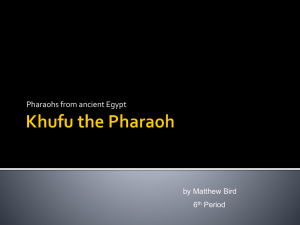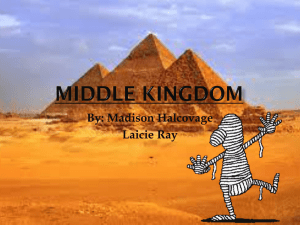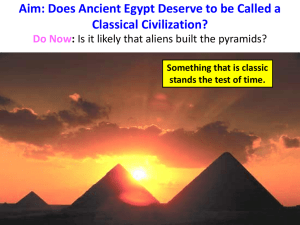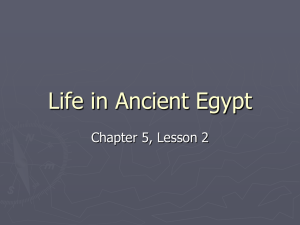AncientEgypt-general 1
advertisement
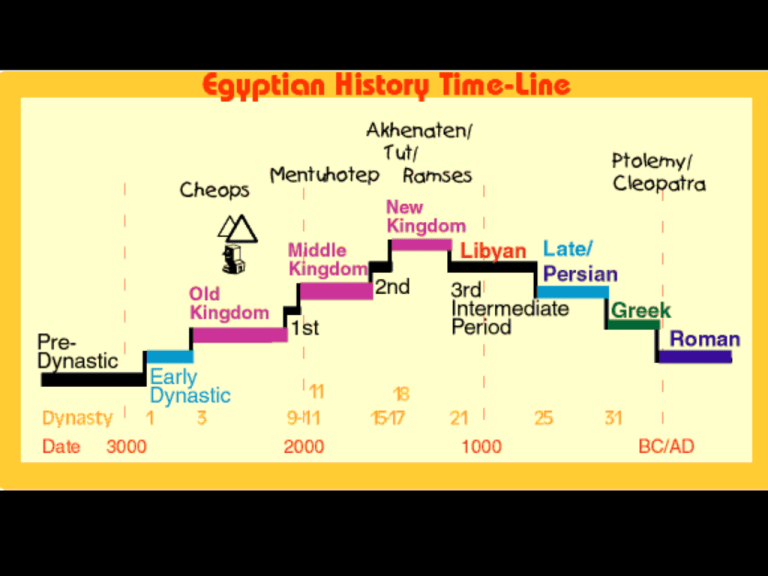
Evidence suggests that a sophisticated culture existed before the Pharaonic Age Egyptians cultivated wheat & barley, domesticated goats, sheep, cattle, pigs, and domesticated the donkey & the cow Egyptians made the first pottery, bricks, cosmetic palettes, and war maces This double crown was there for the union of the two lands. King Menes and his family formed the first ever Egyptian dynasty. A dynasty is when you have a series of rulers who all come the same family. After King Menes died his son became king, when his son died his grandson became king. A mural of Narmer (or Menes) conquering Lower Egypt (c.a. 3100 B.C.E.) Early Dynastic Period c.a. 3100-2700 B.C.E. The Old Kingdom c.a. 2700-2200 B.C.E. First Intermediate Period c.a. 2200-2050 B.C.E. The Middle Kingdom c.a. 2050-1652 B.C.E. Second Intermediate Period c.a. 1652-1567 B.C.E. The New Kingdom c.a. 1567-1069 B.C.E. Third Intermediate Period c.a. 1069-747 B.C.E. Late Period c.a. 747-30 B.C.E. OLD KINGDOM •Pharaohs organized a strong central state, were absolute rulers, and were considered gods. •Egyptians built pyramids at Giza. •Power struggles, crop failures, and cost of pyramids contributed to the collapse of the Old Kingdom. MIDDLE KINGDOM •Large drainage project created arable farmland. •Traders had contacts with Middle East and Crete. •Corruption and rebellions were common. •Hyksos invaded and occupied the delta region. NEW KINGDOM •Powerful pharaohs created a large empire that reached the Euphrates River. •Hatshepsut encouraged trade. •Ramses II expanded Egyptian rule to Syria. •Egyptian power declined. The crook (heka) and the flail or flabellum (nekhakha), are two of the most prominent items in the royal regalia of ancient Egypt. Golden Age of prosperity Witnessed the construction of the first funerary monuments Djoser most well-known pharaoh of 5 pharaohs of the 3rd Dynasty 4th Dynasty—Started with Sneferu and saw the power of the pharaohs reach its climax Sneferu built 3 pyramids, but his son & successor, Khufu credited with building the Great Pyramid of Giza Khufu’s son Khafra built another great pyramid & the Great Sphinx Menkaura—built the last pyramid at Giza and the last pharaoh of the 4th Dynasty Second Pharaoh of the Old Kingdom Built the first step pyramid at Saqqara, the largest necropolis in Memphis Designed by architect Imhotep as a stone replica of Djoser’s palace Built entirely from cut cubic stone - Built on the plateau of Giza at the edge of modern Cairo - Built for the pharaohs of the 4th Dynasty: Khufu, Khafra, & Menkaura Architecturally Most impressive of pyramids in Egypt Completely made of cut stone & largely remain intact today For administrative purposes, Egypt was divided up into provinces, or nomes. A governor, or nomarch, was at the head of each nome and was responsible to the pharaoh. These governors tended to amass large holding of land and power within their nomes, creating a potential rivalry with the pharaohs. Of special importance to the administration of the state was a vast bureaucracy of scribes who kept records of everything. Armed with the knowledge of writing and reading, they were highly regarded and considered themselves a superior class of men. Their high standard of living reflected exalted status. Seated Scribe, from Saqqara. c.a. 2400 B.C.E. their Chief advisor of Pharaoh (P.M.) Viziers judged most of the cases in their capital courts. The Pharaoh appointed two viziers, one for Upper and one for Lower The vizier was responsible for: civil law and order collection of taxes maintenance of archives mobilization of troops, Imhotep: famous Vizier that designed the step pyramid Old Kingdom: the most stable period the Pharaoh dominated life forstalled the emergence of provincial power but gradually lost power to royal officials gradual drying of the environment failure of the Nile to flood on time The End of the Old Kingdom Relief showing men, women, and children suffering from the effects of severe famine Professor Fekri Hassan examining ancient hieroglyphs which tell of appalling suffering. A third of the population died and the most ordered of empires was brought to chaos. Pharaonic power reached its peak Referred to country’s “Golden Age” due to great heights in pictorial art & literature Capital in Thebes, not Memphis Deir el-Bahri Mortuary temple of Hatshepsut from above. Successfully reduced the power of the nomarchs & the power over the nomes Because the power & wealth of nomarchs rivaled that of the pharaoh, Senusret III abolished the nomes He established a new form of regional government, thus consolidating power in the hands of the pharaoh Senusret III Ended the Middle Kingdom in Ancient Egypt by invasion Semite Peoples Introduced the wheel and horse to Egypt Starting in 1567 B.C.E., the pharaoh Ahmose I eventually managed to defeat and expel the Hyksos from Egypt, reuniting Egypt and establishing the New Kingdom (c. 1567-1085 B.C.E.). The New Kingdom was characterized by a new militaristic and imperialistic path. A more professional army was developed. Ahmose and his army driving out the Hyksos. Amenhotep IV (c. 13621347 B.C.E.) introduced the worship of Aton, god of the sun disk, as the chief. For the first time, Egyptians became ‘monotheistic’. Changing his own name to Akhenaten (“It is well with Aton”), the pharaoh closed the temples of other gods. Invasion of the “Sea Peoples” around 1200 B.C.E. The days of Egyptian empire were ended, and the New Kingdom expired with the end of the twentieth dynasty in 1085 B.C.E. For the next thousand years, despite periodic revivals of strength, Egypt was dominated by Libyans, Nubians, Persians, and Macedonians. Egyptian Drawings of Two Different Tribes of Sea People In late 332 B.C.E., Alexander the Great drove the Persians out of the Nile Valley Egyptians saw Alexander as a “liberator” & recognized him as a pharaoh Alexander founded the city of Alexandria, which became a prosperous commercial center and seat of culture The most famous Egyptian of all time She conceived a child (Ptolemy Caesarian) with Julius Caesar After Caesar’s death, she returned to rule Egypt where she forged a relationship with Marc Antony Her suicide in 30 B.C.E. brought to an end the last chapter in the 3,000-year story of Ancient Egypt


